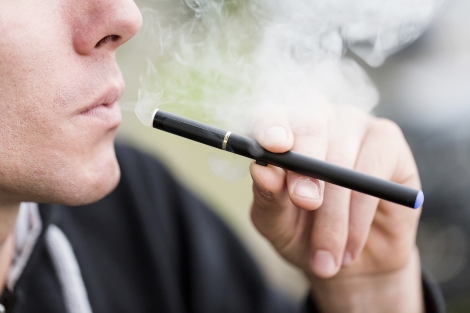E-Cigarette Use Exposes Teens to Toxic Chemicals
Toxic Byproducts Are Found Even in Adolescents Who Use E-cigarettes Without Nicotine
 Adolescents who smoke e-cigarettes are exposed to significant levels of potentially cancer-causing chemicals also found in tobacco cigarettes, even when the e-cigarettes do not contain nicotine, according to a study by UC San Francisco researchers.
Adolescents who smoke e-cigarettes are exposed to significant levels of potentially cancer-causing chemicals also found in tobacco cigarettes, even when the e-cigarettes do not contain nicotine, according to a study by UC San Francisco researchers.
“Teenagers need to be warned that the vapor produced by e-cigarettes is not harmless water vapor, but actually contains some of the same toxic chemicals found in smoke from traditional cigarettes,” said lead author Mark L. Rubinstein, MD, a professor of pediatrics at UCSF. “Teenagers should be inhaling air, not products with toxins in them.”
For the study, published March 5, 2018, in Pediatrics, researchers analyzed urine from a group of adolescents with an average age of 16.4 years. Sixty-seven used e-cigarettes only and 17 used both e-cigarettes and traditional tobacco cigarettes. They were compared with a control group of 20 non-smoking teens.
Levels of toxic organic compounds were up to three times higher on average in the e-cigarette users compared with the controls. In teenagers who used both e-cigarettes and tobacco cigarettes, levels of toxic compounds were up to three times higher than in e-cigarette users only.
“E-cigarettes are marketed to adults who are trying to reduce or quit smoking as a safer alternative to cigarettes,” said Rubinstein. “While they may be beneficial to adults as a form of harm reduction, kids should not be using them at all.”
It was the first known study to report on the presence of potentially cancer-causing compounds in the bodies of adolescents who use e-cigarettes. The list of compounds included acrylonitrile, acrolein, propylene oxide, acrylamide and crotonaldehyde.
Rubinstein noted that some of the toxic chemicals were found in the bodies of teens who used flavored e-cigarettes without nicotine. He explained that propylene glycol and glycerin, which are used to keep the products smoked in e-cigarettes in liquid form, are approved by the Food and Drug administration as safe at room temperature. “But when they’re heated to the high temperatures required for vaporization, they can produce toxic substances that are potentially carcinogenic,” he said.
Co-authors of the study were Kevin Delucchi, PhD, Neal L. Benowitz, MD, and Danielle E. Ramo, PhD, of UCSF.
The study was funded by the National Institutes of Health grant numbers R21DA040718, P50 CA180890, P30 DA012393, S10 RR026437 and TRDRP 24XT-0007.
UC San Francisco (UCSF) is a leading university dedicated to promoting health worldwide through advanced biomedical research, graduate-level education in the life sciences and health professions, and excellence in patient care. It includes top ranked graduate schools of dentistry, medicine, nursing and pharmacy; a graduate division with nationally renowned programs in basic, biomedical, transitional and population sciences; and a preeminent biomedical research enterprise. It also includes UCSF Health, which comprises three top-ranked hospitals, UCSF Medical Center and UCSF Benioff Children's Hospitals in San Francisco and Oakland, and other partner and affiliated hospitals and healthcare providers throughout the Bay Area.